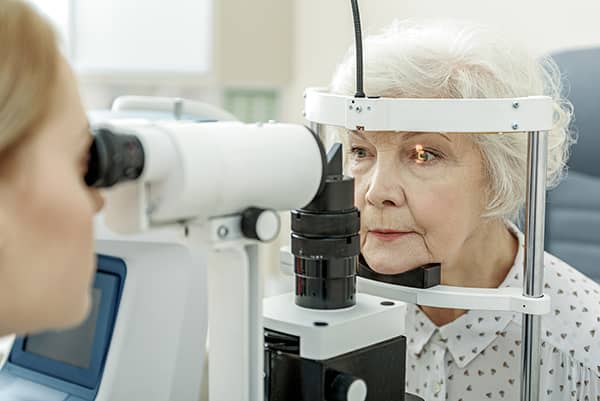Cataract surgery is a common surgical procedure that involves removing the cloudy natural lens of a person’s eye that limits the patient’s range of vision and replacing it with an artificial one for improved visual outcome.
The CATALYS laser procedure enables us to safely remove and then insert new clear artificial intraocular lenses (IOLs) into your eyes. Using advanced cataract surgery technology we ensure great outcomes for our patients, enabling them to enjoy good vision without glasses.
Am I the right candidate for cataract surgery?
Several things must be taken into consideration before deciding whether or not you qualify for the cataract surgery process. For example, if you have diabetes, you’ll need to undergo diabetic eye exams every six months. Also, if you smoke, you’ll need to quit smoking before having the surgery. Finally, if you have glaucoma, you’ll need to see an ophthalmologist regularly.
There is no age limitation for cataract corrections. With modern technology, there is no reason why anyone cannot get their eyes fixed at any age.
Before cataract surgery: What causes cataracts?
As we age, the proteins and fibers of the eye begin to break down, causing hazy or blurry vision. This is a common condition affecting the lenses of the eyes that is known as cataracts.
There isn’t yet any understanding of what exactly leads to cataracts. However, scientists do understand that some risk factors for cataracts include:
- Diabetes
- Steroids
- Smoking
- Exposure to the sun’s ultraviolet radiation (especially in places near the equator, such as Hawaii).
Many people don’t notice a significant difference in their vision at first. They use glasses, bright lights, or magnifying lenses to make up for the changes in their vision. Eventually, however, this gradual loss of vision can dramatically reduce their quality of life by limiting their activities.

What is the CATALYS Laser Cataract Procedure?
The Premium Laser Cataract procedure is a form of cataract surgery that uses the CATALYS laser and premium intraocular implants to ensure accuracy and comfort. This procedure improves traditional cataract surgery in several ways:
There isn’t yet any understanding of what exactly leads to cataracts. However, scientists do understand that some risk factors for cataracts include:
- Makes corneal incisions with remarkable precision
- Softens the cataract to remove it more easily
- Replaces the tissue with an artificial lens more quickly and easily
- Premium, multifocal lenses provide improved vision for BOTH far and near vision decreasing the need for any glasses.
Overall, Premium Laser Cataract Surgery with Premium Intraocular Lenses (IOLs) is a faster and better way for cataract removal than traditional methods.

Benefits of Premium Laser Cataract Surgery
With the development of cataracts, you may notice a steady decline in your quality of life as your vision becomes progressively clouded. You might stop doing the things that you love, like reading or driving, without even realizing you are doing so.
Cataract surgeries improve people’s lives by allowing them to enjoy daily activities they previously couldn’t because of poor eyesight. Most cataract sufferers consider the potential risk of complications from cataract surgeries to be worth the benefit.
Since many of those affected by cataracts are seniors and people with “diabetic eyes” or other eye diseases, cataract surgery can also reduce the risk of serious injury. The chances of falling and being grievously injured decrease dramatically in patients after cataract surgery.
Your Laser cataract surgery Consultation
The first step in your journey to improved vision at Eyesight Hawaii is your consultation. Your consultation will determine if you are a good candidate for CATALYS Laser cataract surgery. A CATALYS consultation includes:
- A refractive and dilated eye exam
- A discussion of your eligibility for cataract surgery
- Information about the benefits and risks of CATALYS with premium IOLs
- An opportunity to ask questions and address any concerns about your treatment plan

Preparing for Laser Cataract Surgery
You will be instructed to stop wearing soft contact lenses three days to a week before your surgery.
Makeup, perfume, cologne, and body spray interfere with the laser and medications used in the procedure. You will be advised not to wear any of these products on the day of your procedure.


HOW LASER CATARACT SURGERY WORKS
With the CATALYS laser, cataract surgery is safer and more precise than ever before. Your surgeon will start by making incisions in the cornea. The Laser allows the cataract eye doctor to cut an opening in the lens in the precise shape and location of the cataract.
Then, they will use the laser to soften the cataract and break it up into smaller, more manageable pieces. Traditional cataract surgery uses a combination of surgical instruments and ultrasound to break up the cataract into smaller pieces, which the surgeon then removes. CATALYS allows the cataract surgeon to remove the softened cataract more quickly, using less energy.
The cataract specialist then replaces the lens with a premium IOL to restore the patient’s vision. The gentle approach of the CATALYS laser can lessen recovery times while the ability to make precise incisions lowers the cataract surgery risks.
RECOVERING FROM CATARACT SURGERY
On the day of the surgery, you will need to ask a family member or friend to drive you to and from your appointment. Vision after cataract surgery will need time to adjust for the moderate discomfort, and for the first few hours, you may notice wavy, blurred vision, or double vision. You will want a pair of dark sunglasses to wear home after surgery and you may want to take two to three days off of work to allow your eyes time to adjust.
Once the surgery is completed, you’ll likely notice swelling in your eyes. This is called corneal edema and it usually occurs right after the procedure. Corneal edema after cataract surgery is caused by fluid leaking into the eye from the incision sites. It typically goes away within 24 hours but sometimes lasts up to two weeks.
The cataract surgery recovery process will vary from patient to patient. Most cataract surgery patients see a noticeable improvement within one to three days after surgery. Don’t worry though, if your recovery takes longer than expected. It can often last anywhere from three to ten weeks before you start seeing the full visual recovery of your operation.

What Patients Say
FREQUENTLY ASKED QUESTIONS ABOUT LASER CATARACT SURGERY
Traditional cataract surgery is a well-known medical procedure that is covered by most private insurance and Medicare. However insurance does not cover the upgrades of CATALYS Laser surgery or Multifocal IOL, the average estimated cost for CATALYS Laser eye surgery with premium IOLs is between $3700 and $5000 per eye.
Like any surgery, cataract surgery comes with certain risks. One of the most common consequences is posterior capsular opacification (PCO). PCO is where a tissue behind the artificial lens becomes cloudy, making it feel as though your cataract has returned.
Other possible complications include infection, detachment of the retina, inflammation, swelling, glaucoma, bleeding, and worsening of existing eye conditions.
Multifocal intraocular lenses are a type of lens used in cataract surgery. Unlike Monofocal lenses (such as Acrysof IQ), they allow people who have age-related presbyopia to see at multiple distances without needing glasses or contact lenses. The most advanced and highest quality lenses on the market, premium IOLs are known for providing better vision than other types of multifocal intraocular lenses.
There are several options during your cataract surgery. Standard IOL implants will help your vision become clear, however, you may still need to wear reading glasses like you did before cataracts developed.
Cataracts may not always obscure vision significantly. They start out of small magnitude and are almost inconspicuous to the afflicted individual. If a cataract evolves so that sight is impeded or it starts affecting the quality of life, then it should be extracted. On the other hand, if remains static, surgery is not necessary.
It’s essential to have comprehensive vision exams with your eye doctor frequently in order to track the development of cataracts and determine when it’s time for surgery.
Contact Us Today
If you are looking for treatment options and want state-of-the-art laser eye surgery to cure your condition, the cataract treatment specialists at EyeSight Hawaii in Honolulu, HI, and Maui, HI has the experience and knowledge to help. Make an appointment online or call our office to schedule a consultation today!

